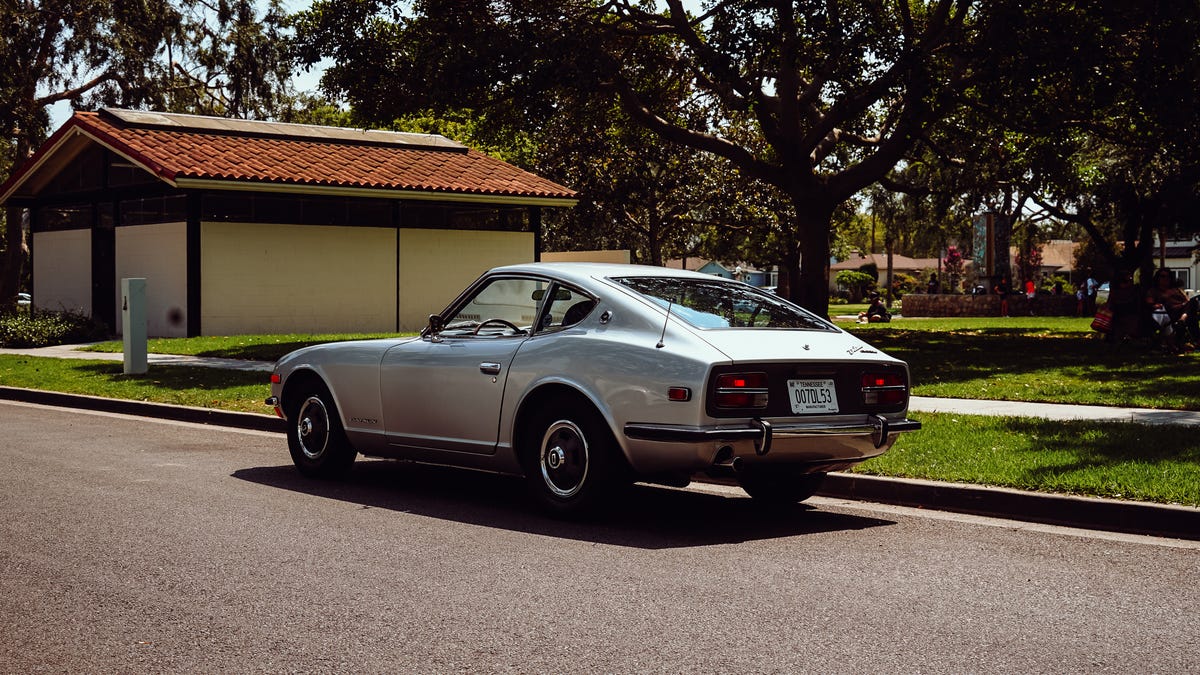1972 Nissan Datsun 240Z quick drive review: Meet your heroes
In which I risk shattering the delicate film of nostalgia surrounding one of the largest-looming cars of my youth.
I love classic cars. I love them more than I like most people. I've owned a handful -- a 1977 Alfa Romeo Alfetta, a 1966 Volvo 122s and my current 1970 Mercedes-Benz 280SE -- but I've never owned or even driven a Datsun 240Z, and part of that is based on fear.
Now, when I say fear, I don't mean the kind of visceral fear of driving something valuable with all the crash protection of a wet paper bag. No, it's the fear of experiencing something that I loved as a kid and upon which the golden sheen of nostalgia still lies thick, only to have it ruined. You know, don't meet your heroes. But despite all that, shortly after the debut of the 2023 Z, Nissan offered me the chance to drive one of its factory-restored Vintage Z program cars, and I said yes, because I'm not an idiot.
A big part of my love for old cars -- and Datsuns in particular -- stems from growing up around vintage racing in the Pacific Northwest, where my dad worked as a contractor providing radios to safety personnel. Every other weekend I was up to my eyeballs in classic Porsches, Alfas, BMWs and, yes, Datsuns. I loved the sound that the 510s, roadsters and especially the Zs made as they pounded around what was then called Seattle International Raceway. How could a road car live up to that?
Six cylinders, two carburetors and all the personality in the world.
As it turns out, that's part of the beauty of old cars. This particular 1972 Datsun 240Z was restored back in 1997 by Nissan and has been driven approximately 50,000 miles in the intervening years. The car feels fresh-ish but still very much like an inexpensive car from the 1970s. There are squeaks and rattles and, being carbureted and uncatalyzed, the pervasive stink of fuel surrounds the car like a force field against modernity (and the California Air Resources Board). It's louder than I would have expected, too, and while the tone is undoubtedly tamer than the road-racing Zs of my youth, that same sound is still there, just muted slightly.
Another wonderful thing about old cars is just how tactile they are. This has become something of a car-writing cliche -- steering feel, analog cars, blah blah blah -- but it's true. The thin-rimmed and definitely never-came-from-a-tree "wood" steering wheel is a chore to crank at low speed, but when the pace picks up, it begins to talk in its own language of vibrations and wriggles.
The same is true for the shifter. The four-speed manual in this Z doesn't feel anywhere in the vicinity of modern, with some vagueness between second and third, of which I need to be mindful. Still, the shifter is solid, and while it requires deliberate thought and considered movement to make it do what you want, especially smoothly, this effort provides that lovely lab-rat-who-gets-the-food-pellet endorphin hit with every satisfying gear change.
That wheel isn't wood, those seats aren't leather, but the experience is better for it.
Getting the old, silver Z out of the parking lot and onto the road immediately begins to reinforce, rather than erode, my love of these cars. The suspension is soft but controlled. The front disc and rear drum brakes are heavy at the pedal but offer enough feel and stopping power that they're not scary to use. The engine is tractable and smooth, despite only producing 151 very-cheaty SAE Gross horsepower and 146 pound-feet of torque, the 2.4-liter dual-carbureted L24 inline-6 revving out and making wonderful noises, all smooth and melodious, and very unlike modern inline-6es with all their raspy, violent-sounding exhaust notes.
While the exterior styling of the Z is easy to love thanks to its archetypical long hood and short deck, the inside is equally fantastic. It isn't anything approaching luxurious, but it's all functional and aesthetically pleasing. Everything from the phony wood wheel and ventilated vinyl seats is meant to look like some other, more premium material, but the ruse all just works in this environment. How could you not love the fake diamond quilting on the vinyl of the cargo area?
I am sweaty and reeking of exhaust and gas fumes by the end of my short drive, but I'm also ecstatic. It's everything that I dreamed the Zs of my childhood would be. While the world of internet car auctions have assured me that I will likely never park one of these early Z cars in my garage, it's going to be an experience that stays with me for a long time, slowly and quietly building its own candy shell of nostalgia in the back of my brain.


